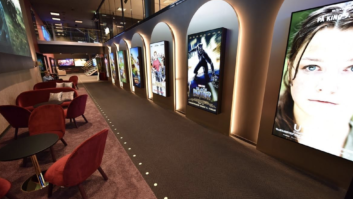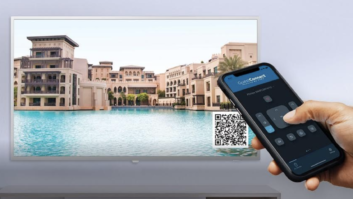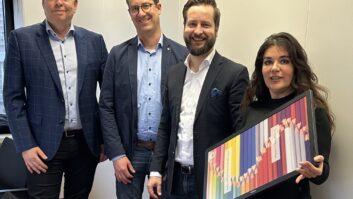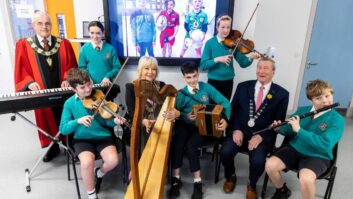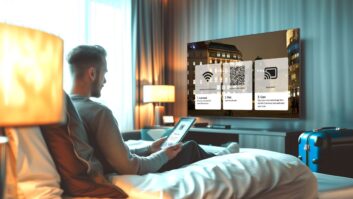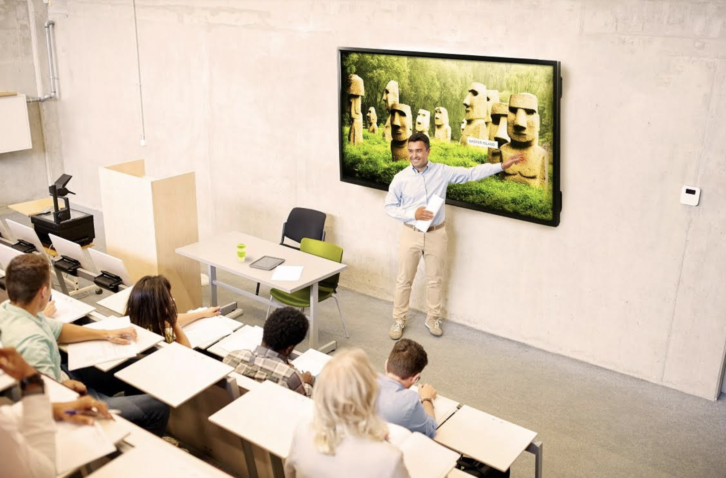
Harold Niericker, head of product management for signage, Philips PDS, explains why connected interactive displays provide the glue to engaging and empowering students and tutors…
Educational technology is not a new concept. Whether in a small classroom or a vast lecture theatre, the role of audiovisual technology has played an important, if not always significant, role in the way lessons are taught and the way students learn.
In today’s 21st century digital world, we are far removed from wheeling a TV and VCR into the classroom – the opportunities for educational tech to enhance learning have never been greater or more varied. Regular visitors to ISE or Bett Show have been able to visualise and appreciate the market’s continued evolution – with hundreds, if not thousands, of companies promising the next variation of ‘revolutionary’ and ‘innovative’ products.
With global spending expected to top $314 billion by 2025 (up 11 per cent per annum), and considering these uncertain times, finding the right solution and getting maximum return on investment are imperative. The beauty, and perhaps the curse, of educational technology, though, is in its variety. Delivering a solution that takes classrooms and educational settings seamlessly from the status quo into the future, with software that is intuitive for educators and students to use, is key.
The consensus among EdTech professionals is that education will spearhead the ‘bounce back’ from the current pandemic crisis. With budgets agreed, there will be a surge for project completion as integrators (as well as teachers and students!) return to campus.
Staying engaged
It’s important to remember that the role of technology is to solve existing issues in the classroom, benefitting both students and teachers in the process.
Philips Professional Display Solutions has been conducting extensive research in this space in order to identify and understand what students and tutors want/need – consulting with leading educators from around the world in a bid to find a solution.
Starting from the ground up, the most important element is around maintaining focus and engagement throughout – for everyone.
According to some psychologists, the average student’s attention span is between 10-15 minutes. With classes and lectures typically lasting between an hour and 90 minutes, the problem is evident. Incidentally, the figures for adults in a business meeting are almost identical (but that’s for another time). Why is this?
Distractions
In today’s modern digital world, distractions come from all angles, particularly in our personal lives. Recent research shows that 30% of people in the UK now own five or more connected devices, including laptops, smartphones, smart TVs, tablets and, increasingly, smartwatches.
With a growing desire for access to live, up to the minute information, linear or non-linear content and the opportunity to comment via social media (there are 350,000 Tweets sent every minute), our brains are becoming super stimulated and over active, making it difficult, almost unnatural, to concentrate on something singular. Switching from this state of multiple focuses to a mindset more appropriate for a classroom, traditionally demanding inactive silences and head-down notetaking, can be difficult.
Involvement evolvement
The task, therefore in keeping the new and next generation engaged within a traditional educational setting is, and will continue to become, increasingly strained.
Character development, collaborative learning and creative thinking are what Philips Professional Display Solutions found to be essential ingredients for any educational environment. Students should feel empowered and involved – therefore collaboration between tutors and students alike should be seamless, encouraged and demanded.
Improved learning through rich media
Statistically, 65 per cent of the population has a visual memory. This indicates the need for more advanced visual presentation of information.
Philips Professional Display Solutions believes interactive displays hold the key to providing the simplest, most effective and most inclusive solution, giving people the opportunity to absorb information in multiple formats, such as audio, pictures and video and ensuring classes remain a hive of creative activity. These findings helped the product teams at Philips Professional Display Solutions create their latest range of interactive education displays (T-Line), bridging the gap between our personal lives and our working (academic) ones. Teachers often report that increased attentiveness and engagement are the top benefits of teaching with interactive display technology.
Screenshare
Displays no longer need to be the centrepiece of the room. For students near the front, they were fine, but for those at the back, or for those with less than perfect eyesight, a single display can be problematic. As at home, screen sharing solves the problem, allowing students to wirelessly connect their own device (tablet, mobile, PC or laptop) directly to the display, ensuring a perfect front row view wherever they are sat.
Take note
Note taking comes with a host of problems, with students running the risk of missing vital parts of the information being disseminated to them, while at the same time removing themselves from debate. The flow of a lesson can also be harmed, with tutors forced to pause while students ‘catch up’.
It’s widely acknowledged that only 20 per cent of information is retained after initial memorisation. Without review, 47 per cent of learned information is lost after only 20 minutes. After one day, 62 per cent of learned information is lost without review.
With an interactive display, teachers can bring students further into the subject matter in real time, so they can discuss and participate actively instead of taking notes, with the added benefit that they remained engaged throughout.
Video conferencing
Video conferencing platforms, of which there are many to choose from, open new opportunities for students to interact with people outside the room, such as guest speakers. Likewise, students unable to make it to class can join in remotely and participate as if they were in the room.
Instant feedback
Team members and students can provide immediate feedback (anonymously without raising hands) via interactive controls that they can use to ask and answer questions about the presented material. This allows the instructor to quickly identify areas of confusion and tailor the materials in real-time.
Introducing new tech, instinctively
Talking with teachers, at every level of education, introducing new technology into the classroom comes with uncertainty. Providing a solution that runs on a commonly used operating system for intuitive ease of use, and that can be easily integrated into the existing education software infrastructure for seamless is, therefore, vital.
The new T-Line range is designed for all levels of education, from Early Years, infants and juniors, through to senior schools, academies, universities and remote studies. Running on Android, the most used OS on the planet, the fear factor is removed, encouraging students to take part and removing any delays during setup, ensuring lesson times are maximised.
As Malcom X once famously said, ‘education is the passport to the future, for tomorrow belongs to those who prepare for it today’.
